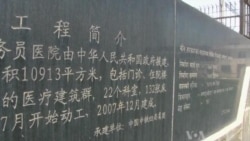KATHMANDU —
In recent years, Nepal has deepened its already strong ties with China - some say to counter its reliance on India for aid and investment.
In a sprawling 132-bed hospital in Nepal’s capital, patients receive treatment for everything from blood disorders to heart disease - vital services in a country that the United Nations ranks 157th in the world for human development.
The Civil Service Hospital, which treats the country’s 86,000 government workers as well as the general public, was inaugurated in 2009 and built by the Chinese government.
Hospital Director Bimal Kumar Thapa says Chinese assistance did not end with construction of the building.
“They will train our staff, doctors and technicians, and they will transfer the skill and transfer the technology through this hospital in Nepal and we will provide better and better service,” Thapa said.
China’s direct investment in Nepal nearly doubled between 2007 and 2011, with the East Asian giant funding everything from new roads to hydropower projects.
Nepali Times Editor Kunda Dixit says it would be absurd if a next-door neighbor of China would see a drop in investment at a time when Chinese investment is growing everywhere else in the world. He adds that Nepal also wants to come out from the shadow of India - its biggest trading partner.
“Geopolitically, successive Nepali governments have tried to lean over backwards to be close to China to offset our overwhelming economic and political dependence on India,” Dixit said.
Evidence of China and Nepal’s strong ties can even be seen here in Nepal’s education system, where more than 60 schools throughout the country offer courses in Chinese to children as young as seven years old.
Valley View School Secondary School in Kathmandu has been offering Chinese language classes to students for the last five years.
Principal Dev Raj Paneru says the instruction is key as more Nepali students and Chinese tourists cross the border.
“Nepali students prefer visiting China for further studies in technical fields and besides, we feel that Chinese occupancy [presence] in the market has increased a lot,” Paneru said.
Teacher Wan Hai Lu moved to Kathmandu from outside Beijing two years ago to teach here as part of a program set up by the Chinese embassy.
“From the development of China, I think many [Nepali] people want to learn Chinese words, so I come to Nepal and I think this is a win-win business,” Li said.
For many in the impoverished Himalayan nation of 30 million, the hope is that being landlocked between two emerging superpowers will pay off even more in the future.
In a sprawling 132-bed hospital in Nepal’s capital, patients receive treatment for everything from blood disorders to heart disease - vital services in a country that the United Nations ranks 157th in the world for human development.
The Civil Service Hospital, which treats the country’s 86,000 government workers as well as the general public, was inaugurated in 2009 and built by the Chinese government.
Hospital Director Bimal Kumar Thapa says Chinese assistance did not end with construction of the building.
“They will train our staff, doctors and technicians, and they will transfer the skill and transfer the technology through this hospital in Nepal and we will provide better and better service,” Thapa said.
China’s direct investment in Nepal nearly doubled between 2007 and 2011, with the East Asian giant funding everything from new roads to hydropower projects.
Nepali Times Editor Kunda Dixit says it would be absurd if a next-door neighbor of China would see a drop in investment at a time when Chinese investment is growing everywhere else in the world. He adds that Nepal also wants to come out from the shadow of India - its biggest trading partner.
“Geopolitically, successive Nepali governments have tried to lean over backwards to be close to China to offset our overwhelming economic and political dependence on India,” Dixit said.
Evidence of China and Nepal’s strong ties can even be seen here in Nepal’s education system, where more than 60 schools throughout the country offer courses in Chinese to children as young as seven years old.
Valley View School Secondary School in Kathmandu has been offering Chinese language classes to students for the last five years.
Principal Dev Raj Paneru says the instruction is key as more Nepali students and Chinese tourists cross the border.
“Nepali students prefer visiting China for further studies in technical fields and besides, we feel that Chinese occupancy [presence] in the market has increased a lot,” Paneru said.
Teacher Wan Hai Lu moved to Kathmandu from outside Beijing two years ago to teach here as part of a program set up by the Chinese embassy.
“From the development of China, I think many [Nepali] people want to learn Chinese words, so I come to Nepal and I think this is a win-win business,” Li said.
For many in the impoverished Himalayan nation of 30 million, the hope is that being landlocked between two emerging superpowers will pay off even more in the future.






